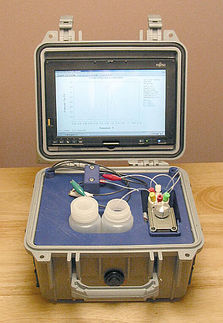Detecting tiny twists with a nanomachine
Nanoscale device may reveal spin-dependent fundamental forces and provide new methods of characterizing torque-generating molecules and DNA strands
Researchers at Boston University working with collaborators in Germany, France and Korea have developed a nanoscale torsion resonator that measures miniscule amounts of twisting or torque in a metallic nanowire. This device, the size of a speck of dust, might enable measurements of the untwisting of DNA and have applications in spintronics, fundamental physics, chemistry and biology.
Spin-induced torque is central to understanding experiments, from the measurement of angular momentum of photons to the measurement of the gyromagnetic factor of metals and a very miniaturized – about 6 microns - version of a gyroscope that measures the torques produced by electrons changing their spin states. It can be used to uncover new spin-dependent fundamental forces in particle physics, according to Raj Mohanty, Boston University Associate Professor of Physics.
"This is perhaps the most sensitive torque measurement every reported," said Mohanty. "The size of the torque measured by this experiment is smaller than the typical torque produced by the untwisting of a doubly-stranded DNA."
In a just released paper in Nature Nanotechnology entitled "Nanomechanical detection of itinerant electron spin flip," Mohanty and his research team developed a highly sensitive way to directly measure torque using microelectronic mechanical systems with spin electronics. Their approach was to detect and control spin-flip torque - a phenomenon that occurs in a metallic nanowire, that is half ferromagnetic and the other is nonmagnetic. The spins of itinerant electrons are "flipped" at the interface between the two regions to produce a torque.
The team developed a microscopic spin-torsion device fabricated by electron beam lithography and nanomachining that mechanically measures the changes in spin states in a magnetic field. This device was operated at one tenth of a degree close to absolute zero.
The team has been working on demonstrating the opposite effect. Under the application of an external torque spin-up and spin-down electrons can be separated to two physically distinct locations, creating a spin battery. This is similar to a conventional charge battery with positive and negative polarities. When connected with an electrical path, electricity flows from one side to the other. But instead of electric current, the flow in the spin battery involves the spin – which can be used to store and manipulate information, the basis of an emerging technology called spintronics.
"The measurements with a nanoscale torsion resonator will be useful in uncovering new fundamental forces and, in theory, for characterizing torque producing molecules and DNA." said Mohanty.
Most read news
Organizations
Other news from the department science

Get the analytics and lab tech industry in your inbox
By submitting this form you agree that LUMITOS AG will send you the newsletter(s) selected above by email. Your data will not be passed on to third parties. Your data will be stored and processed in accordance with our data protection regulations. LUMITOS may contact you by email for the purpose of advertising or market and opinion surveys. You can revoke your consent at any time without giving reasons to LUMITOS AG, Ernst-Augustin-Str. 2, 12489 Berlin, Germany or by e-mail at revoke@lumitos.com with effect for the future. In addition, each email contains a link to unsubscribe from the corresponding newsletter.





















































